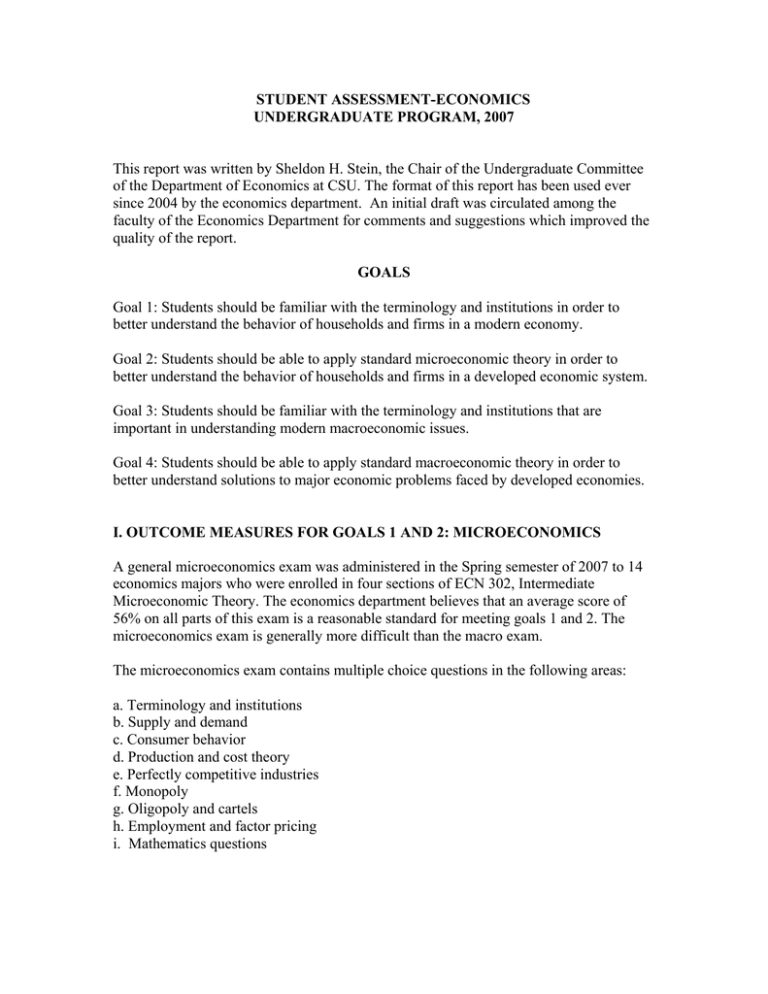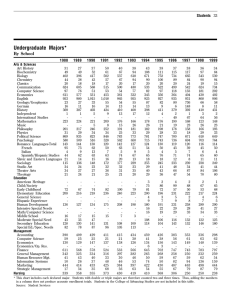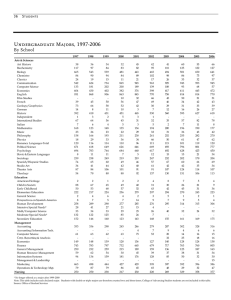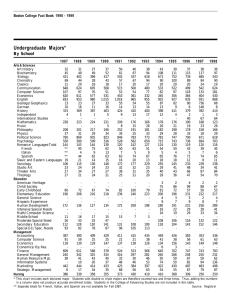STUDENT ASSESSMENT-ECONOMICS UNDERGRADUATE PROGRAM, 2007
advertisement

STUDENT ASSESSMENT-ECONOMICS UNDERGRADUATE PROGRAM, 2007 This report was written by Sheldon H. Stein, the Chair of the Undergraduate Committee of the Department of Economics at CSU. The format of this report has been used ever since 2004 by the economics department. An initial draft was circulated among the faculty of the Economics Department for comments and suggestions which improved the quality of the report. GOALS Goal 1: Students should be familiar with the terminology and institutions in order to better understand the behavior of households and firms in a modern economy. Goal 2: Students should be able to apply standard microeconomic theory in order to better understand the behavior of households and firms in a developed economic system. Goal 3: Students should be familiar with the terminology and institutions that are important in understanding modern macroeconomic issues. Goal 4: Students should be able to apply standard macroeconomic theory in order to better understand solutions to major economic problems faced by developed economies. I. OUTCOME MEASURES FOR GOALS 1 AND 2: MICROECONOMICS A general microeconomics exam was administered in the Spring semester of 2007 to 14 economics majors who were enrolled in four sections of ECN 302, Intermediate Microeconomic Theory. The economics department believes that an average score of 56% on all parts of this exam is a reasonable standard for meeting goals 1 and 2. The microeconomics exam is generally more difficult than the macro exam. The microeconomics exam contains multiple choice questions in the following areas: a. Terminology and institutions b. Supply and demand c. Consumer behavior d. Production and cost theory e. Perfectly competitive industries f. Monopoly g. Oligopoly and cartels h. Employment and factor pricing i. Mathematics questions In addition, this year, four questions were added to the exam to test the minimum necessary mathematical skills needed for a student to succeed in an intermediate microeconomic theory course. The average score obtained by the fourteen economics majors tested this year was 40% for all of the economics questions on the exam (parts a through h) of the exam and 43% for all questions on the exam, including the math questions (parts a through i). Last year, the average score obtained for parts a through h was 54% for the economics questions on the exam (parts a through h) and 56% for all of the questions on the exam, including the math questions (parts a through i). Since this test is identical to the one used last year, the results are directly comparable to last years results. 2005 2006 2007 a. Terminology and institutions b. Supply and demand c. Consumer behavior d. Production and cost theory e. Perfectly competitive industries f. Monopoly g. Oligopoly and cartels h. Employment and factor pricing 69% 72% 40% 48% 58% 46% 80% 55% 63% 53% 34% 52% 46% 63% 69% 50% 40% 43%. 38% 39% 34% 40% 50% 43% i. Mathematics questions ----- 77% 70% This year, we did not meet the strict 56% standard on any of the economics sections of the test, unlike the performance in 2005 when the criterion was met on 4 sections and 2006 when the criterion was met on 3 sections. The assessment test in microeconomics was administered to all students enrolled in ECN 302 during the spring semester of 2007. The following table presents the performance of economics majors and the entire group of students enrolled in ECN 302 in the spring semester of 2007. Economics majors make up about 10% of those enrolled in ECN 302: SPRING 2007 MAJORS ECONOMICS QUESTIONS MATHEMATICS QUESTIONS 40% 70% ALL STUDENTS 45% 73% In the Spring of 2006, the economics majors outperformed the entire group in both the economics section of the assessment test and the math test: SPRING 2006 MAJORS ECONOMICS QUESTIONS MATHEMATICS QUESTIONS 54% 77% ALL STUDENTS 43% 66% The performance of the entire group, both majors and nonmajors alike, rose from 43% in 2006 to 45% in 2007 on the economics questions. Since 154 students took the assessment test in microeconomics last spring, we have an apparent anomaly. Between 2006 and 2007, the performance of the economics majors fell precipitously while the performance of the nonmajors improved since our majors only made up about 10% of the students in the ECN 302 sections. The performance of the economics majors on the four math questions included in the assessment exam dropped from 77% to 70% while the performance of the group as a whole improved from 66% to 73%. Since these math questions are very basic algebra problems that any ninth grader should be able to answer, one suspects that the mediocre performance of students in ECN 302 reflects the level of math skills that our students bring with them into the classroom. Since there is inevitably a certain amount of aggregation error when we lump questions together and analyze them by broad categories, we now examine each question separately to determine the “small picture.” This table is presented as Appendix A, where the microeconomic concept that the question examines is presented. This table shows the performance of economics majors in 2006 and 2007 and the entire group in 2007. We note the following: • In 2006, of the 37 microeconomics questions on the assessment exam, our majors met the 56% standard 19 times. In 2007, economics majors met the 56% standard 9 times. • In 2006, the entire group met the 56% standard 8 times. In 2007, the entire group met the 56% standard 11 times. At the beginning of the Spring semester, each instructor teaching a section of ECN 302 was given a copy of the assessment exam as well as the performance of the 2006 students for each question. This may have been responsible for the better overall performance of the 2007 group. As for the economics majors, since only 16 of them took the test in 2006 and only 14 of them took it in 2007, the small numbers involved may make statistical inference problematical. Were last year’s economics majors of higher quality than this year’s? The only way to answer this question would be for students taking the assessment test to identify themselves on the answer sheet and use a metric such as overall grade point average and/or grade point average in economics courses in analyzing the assessment test data. There is some anecdotal evidence that such a decline in the quality of our majors has taken place. Each year, the department selects an outstanding economics major and provides this individual with an award. In 2003, 2004, 2005, and 2006 we presented this award to two individuals. In 2007, only one individual met our qualifications for the award and the gap between this student and the other seniors in the department was rather large. However, the improvement in the scores of the entire group consisting of both majors and nonmajors is meaningful statistically because of the size of the group we are looking at. To the extent that instructors in ECN 302 made use of the information provided, it may indicate that studying the results of our assessment exams can lead to improved teaching. In closing, there are two additional points that are worth noting. First, one of our ECN 302 instructors gives students extra credit for good performance on the micro assessment test and his average scores are noticeably higher than those of other instructors. Also, this same instructor’s students tend to do much better on the mathematics section of the assessment exam than students in the other sections. This might be something worth looking into during the next academic year. Second, if one examines the topics queried on the micro assessment test, some of them are very basic. The isoquant question can be answered correctly if the student knows that the word “isoquant” is a combination of “iso” meaning “equal” and “quant” referring to quantity. The percentage score on this question has been less than 50%. Many of the topics that appear on this exam are covered in both “principles of microeconomics” and “intermediate microeconomics.” Surely, we can do better. With some additional effort, it should be possible to meet the 56% standard more often than we are doing now. However, would this involve an infringement on “academic freedom?” Do we run the danger of “teaching to the test” if we use the assessment tests to raise their average scores. Is there anything wrong with “teaching to the test” in a collegiate setting, especially when the student’s grade can be determined by tests more challenging than the assessment test if the instructor so chooses. This is something that the undergraduate committee will have to look into next academic year. II. OUTCOME MEASURES FOR GOALS 3 AND 4: MACROECONOMICS A general macroeconomics exam was administered late in the Spring semester of 2007 to 11 economics majors who were enrolled in ECN 301, Intermediate Macroeconomic Theory. The questions were categorized into 10 sub areas of macroeconomics so that we could determine in which areas of macroeconomics our program is achieving goals 1 and 2. We believe that an average score of 66% on all parts of the exam is a demanding, but still reasonable standard for meeting goals 3 and 4. The exam contains multiple choice questions in the following sub areas of macroeconomics: a. Terminology and institutions b. Measuring inflation, the labor force, and unemployment c. Nominal values and real values d. Investment and consumption spending e. Determination of GDP, the price level, and the interest rate f. Money, the money supply, and the Federal Reserve System g. Money creation process h. Theory of money, interest, and inflation i. Fiscal and monetary policy j. International \ The results for the macroeconomics assessment test for 2005, 2006, and 2007 are as follows: Category a b c d e f g h i j Percentage answered correctly 2005 2006 2007 50% 67% 68% 63% 88% 70% 82% 68% 84% 100% 61% 55% 79% 50% 64% 64% 79% 88% 43% 92% 54.6% 50.0% 54.5% 51.5% 65.4% 60.6% 86.4% 69.7% 36.4% 63.6% The overall score on this exam, which is identical to the one administered in 2005, and 2006, was 60% as opposed to 65% in 2005 and 73 in 2004.. This may be the result of the fact that the instructor in ECN 301 in the Spring of 2006 and the Spring of 2007 decided to spend more time on the theory of economic growth, which has never been tested on the macroeconomics assessment test. Given the increasing importance of growth theory in macroeconomics and the fact that new faculty members who will join the economics department in the next few years will probably want to spend more time on growth theory and less time on the business cycle, it may become necessary to revise the macroeconomics assessment test to take these changing trends into account. This may be something that the department should look into next year, especially in light of the turnover in the roster of faculty that has been occurring for the last several years. There may not be much to worry about the precipitous drop in category i since most of our majors of necessity wind up taking ECN 441-Business Fluctuations and Forecasting-which go into this material in greater detail. The same holds true of category d (investment and consumption spending). Perhaps an assessment exam in macroeconomics should be administered after ECN 441 is taken. ECN 441/541 will be taught this summer and the instructor intends to administer the assessment test in macroeconomics to the enrolled students at the end of the semester. SENIOR SURVEY 2007 Five senior economics majors were provided with a survey form on which they could provide an assessment of their experiences in the economics department at CSU and in the university generally. Three of these students expressed an interest entering the job market after graduation. Two of them are considering entering an MBA program and one is considering entering a masters program in economics. Four students said that their post-graduation prospects would have been improved had they been able to take more electives in the economics department. Two indicated that they would have liked to be able to take additional social science courses outside of the economics department. Two of the seniors strongly agreed with the statement that the IST 203 requirement was useful for their other coursework or post graduation plans. Three agreed with this statement. No one disagreed or strongly disagreed with this statement. All five of the students queried disagreed with the statement that “the major field requirements in the economics department should be changed.” Three of the five students were satisfied with their decision to major in economics. But all five said that they would recommend economics as a major to others. On the 4-3-2-1 Likert scale, the average response to the statement “it is possible to schedule electives in the economics department in a timely fashion” was 2.8 The statement “I am satisfied with college and university requirements” elicted an average response of 2.6 on a Likert scale. The statement “I am satisfied with my overall college experience at Cleveland State University” elicited an average response of 3.0 on a Likert scale. OTHER COMMENTS: One student said that the math requirement should be more flexible to allow for transfer credit, that an ethics course should be required and that more electives should be offered. Two students wanted more electives and more available times. One student commented that some courses that required a lot of writing are not eligible for WAC credit. The necessity for freshmen orientation for students who are not first year students was questioned. One student said that with the paucity of elective offerings in the economics department, one is compelled to take certain courses even if you have no interest in them. The comment was made that students should have access to course offerings further into the future than is currently available. One student thinks that two of our faculty are “great econ teachers” but that a third does not deserve to be on our faculty. Another thinks that the diversity requirement is a waste of time. Another complained about getting the CSU runaround when faced with a problem but does not apply that complaint to the economics department. Appendix QT TOPIC 3 4 5 6 7 8 9 10 11 12 13 14 15 16 17 18 19 20 21 22 23 24 25 26 27 28 29 30 31 32 33 34 35 36 37 38 39 40 41 42 43 1 2 nonprice rationing total revenue and elasticity rationing by waiting changes in supply/demand axiom of completeness tax incidence consumer MRS=px/py income/subst effect demand and indifference curves isoquants-the definition diminishing returns returns to scale input prices & cost curves marginal product & cost curves explicit & implicit costs fixed costs and PC operating at a loss in PC short run supply shifts in PC supply and MC in PC profit maximization and monopoly role of profit in PC marginal revenue and monopoly MR=MC and monopoly monopoly dead wt loss opportunity cost sunk cost capital in economics comparative advantage consumers surplus deadweight monopolist loss separating markets in PD profit maximization in PD externality-the definition externality-an example competitive factor pricing factor pricing oligopoly AVERAGE MAJORS 2006 TOTAL 2006 MAJORS 2007 TOTAL 2007 50 56 37.5 50 37.5 69 56.3 25 18.8 43.8 75 25 75 31.3 56.3 43.8 50 6.3 43.8 68.8 87.5 56.3 62.5 62.5 31.3 87.5 62.5 87.5 75 62.5 50 50 87.5 62.5 50 50 68.8 46 45 48 45 35 58 40 31 17 32 51 29 63 25 32 18 31 15 48 43 64 41 41 48 18 71 51 74 69 62 38 28 74 41 51 28 36 21.4 57.1 57.1 28.6 50 50 28.6 42.9 28.6 42.9 50 21.4 71.4 35.7 7.1 28.6 35.7 14.3 42.9 21.4 50 28.6 35.7 78.6 7.1 57.1 42.9 57.1 42.9 64.3 7.1 14.3 64.3 42.9 64.3 21.4 50 47 55 50 47 41 64 38 19 23 43 53 35 65 25 23 23 31 16 56 38 69 38 42 65 11 76 49 73 71 68 31 26 81 53 66 25 44 54.4081081 42.8918919 39.5756757 45.4054




